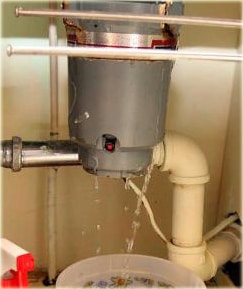Our Comprehensive Guide to Fixing a Leaky Garbage Disposal
Our Comprehensive Guide to Fixing a Leaky Garbage Disposal
Blog Article
Are you interested in tips on Why Is ?

Garbage disposals are essential kitchen devices that help in disposing of food waste successfully. Nonetheless, a dripping waste disposal unit can be a discouraging and unpleasant trouble to deal with. Thankfully, lots of leaks can be dealt with conveniently with a few straightforward actions. In this article, we will discuss just how to deal with a leaking waste disposal unit properly.
Introduction
Garbage disposals are set up under cooking area sinks and are developed to shred food waste into smaller pieces, allowing it to travel through the pipes system conveniently. While these gadgets are generally reputable, leaks can take place with time due to deterioration, loosened connections, or damage to the unit.
Step-by-Step Guide to Taking Care Of a Leaking Waste Disposal Unit
Switch off the Power
Before trying any kind of repairs, ensure that the power to the garbage disposal system is turned off to avoid the risk of electrical shock.
Situate the Leak
Determine the exact area of the leak and establish the cause
Tighten up Links
Utilize a wrench to tighten up any type of loosened connections between the disposal unit and the plumbing system.
Replace Seals or Gaskets
If the leak is due to used seals or gaskets, get rid of the old elements and change them with new ones.
Patching Fractures or Holes
For fractures or openings in the disposal system, use epoxy or a suitable patching material to seal the damaged area.
Recognizing the Source of the Leakage
Before attempting to repair a leaking waste disposal unit, it is important to recognize the source of the leakage. This can normally be done through visual examination or by conducting basic examinations.
Visual Assessment
Check the waste disposal unit system very carefully for any indicators of water leakage. Pay attention to areas around seals, gaskets, and link points.
Checking for Leaks
One method to examine for leaks is by running water through the disposal system and looking for any visible signs of leakage.
Typical Root Causes Of Leakages in Waste Disposals
Worn Seals and Gaskets
Seals and gaskets play an essential role in protecting against water from leaking out of the garbage disposal. In time, these components can deteriorate, leading to leakages around the disposal device.
Loose Links
The links in between the garbage disposal and the plumbing system can become loosened in time, triggering water to leak out throughout operation.
Cracks or Holes in the Disposal Device
Physical damages to the garbage disposal, such as fractures or openings in the real estate, can also result in leakages.
Tools and Materials Needed for Fixing a Dripping Waste Disposal Unit
Before starting the fixing process, collect the necessary devices and materials, including a screwdriver, adjustable wrench, plumbing professional's putty, substitute seals or gaskets, and epoxy or patching material for repairing fractures or openings.
Evaluating the Garbage Disposal After Repair Work
When the repair service is total, evaluate the garbage disposal by running water through it to make sure that the leakage has been settled.
Preventive Maintenance Tips to Prevent Future Leaks
To prevent future leakages, it is important to carry out regular upkeep on your garbage disposal. This consists of maintaining it tidy, preventing putting non-food items or difficult objects down the disposal, and periodically looking for leakages or other concerns.
Final thought
Finally, taking care of a dripping waste disposal unit is a reasonably straightforward procedure that can be finished with standard tools and products. By complying with the steps laid out in this write-up and practicing precautionary upkeep, you can keep your waste disposal unit in good working problem and stay clear of pricey repairs in the future.
HOW TO REPAIR A LEAKING GARBAGE DISPOSAL
The first thing to do if your garbage disposal starts to leak or exhibits other symptoms of wear and tear is to inspect the appliance quickly. Before making any repairs, check for any obvious cracks or damaged parts and turn the disposal off at the power source. Once you have located the issue, several tools might assist you in solving it. Many resources are available to assist you in putting your disposal back in working order, whether by purchasing new parts or professional assistance from a repair technician. So immediately act if you need help with leaky garbage disposal. You can rapidly resolve the problem and enjoy smoothly functioning appliances with thorough troubleshooting and help from web resources.
Food waste is disposed of using a garbage disposal system, which grinds and flushes it down the toilet. A garbage disposal is a motorized device with one or more rotating blades that grinds up food waste into little bits. They are commonly found under the kitchen sink. A dishwasher inlet or connector is often built into garbage disposals, allowing extra water to drain into the sink’s dishwasher. Several things, such as clogs, worn-out components, or damage to the inside walls of the unit, can bring on garbage disposal leaks or other problems.
WHAT ARE SOME COMMON PROBLEMS WITH GARBAGE DISPOSALS?
Jamming: One of the most frequent issues with garbage disposals is jamming. It occurs when hard or fibrous materials, such as bones, potato peels, or fruit pits, get stuck in the disposal’s blades or impeller. It can prevent the unit from operating correctly or cause it to make unusual noises. Clogging: If too much food waste or non-food items are put into the disposal at once, it can lead to clogging. Clogged disposal may result in slow drainage or a complete backup of water in the sink. Grease and fats can also solidify inside the disposal and contribute to clogging. Leaks: Garbage disposals can develop leaks over time. The most common areas for leaks are the sink flange, the discharge pipe connections, or the dishwasher connection. Leaks can cause water damage and need to be addressed promptly. Foul odors: Food residue can build up in disposal over time and cause unpleasant odors. Bacteria and mold growth inside the unit can also contribute to foul smells. Dull blades: The grinding blades in the disposal can become dull over time, resulting in inefficient chopping and grinding of food waste. That may lead to more frequent jams and increased strain on the motor. HOW CAN YOU TELL IF YOUR GARBAGE DISPOSAL IS LEAKING?
Visible water: Check underneath the sink where the garbage disposal is installed. If you notice water pooling or dripping around the unit or any adjacent pipes, it’s a clear sign of a leak. Musty odor: A persistent or moldy smell from your kitchen sink area could indicate a hidden leak. The moisture from a leaking garbage disposal can create a damp environment that promotes mold and mildew growth. Water damage: Examine the area surrounding the garbage disposal for any signs of water damage. Look for water stains, discoloration, or warping on the cabinet floor or walls beneath the sink. Decreased performance: A leak in the garbage disposal can affect its functionality. If you notice that the disposal is not grinding food waste properly or is making unusual noises, it could be due to water damage or a leak compromising its mechanisms. Rust or corrosion: Inspect the garbage disposal for any signs of rust or corrosion. A leaking unit can cause metal components to deteriorate over time. Look for rust-colored stains or deterioration on the disposal unit or surrounding pipes. https://theappliancepeople.com/how-to-repair-a-leaking-garbage-disposal/

Do you appreciate more info about Tips on Fixing a Leaking Garbage Disposal? Try leaving feedback down below. We'd be delighted to see your thinking about this piece. We are looking forward that you visit us again soon. Remember to take the time to share this article if you enjoyed reading it. Thanks for your time. Don't hesitate to come by our site back soon.
Request Free Estimate Report this page